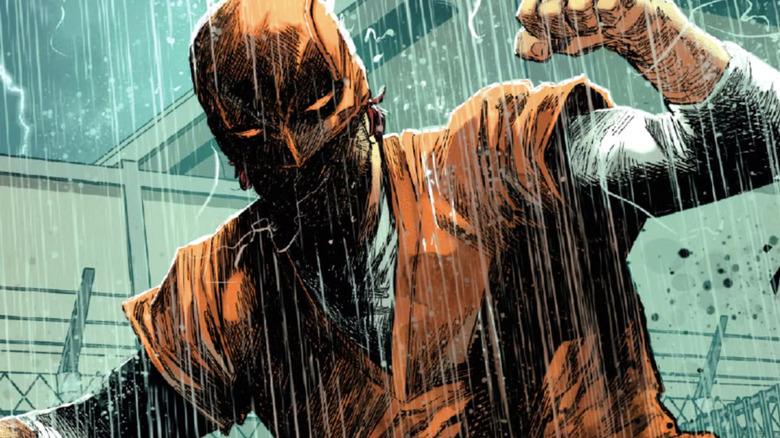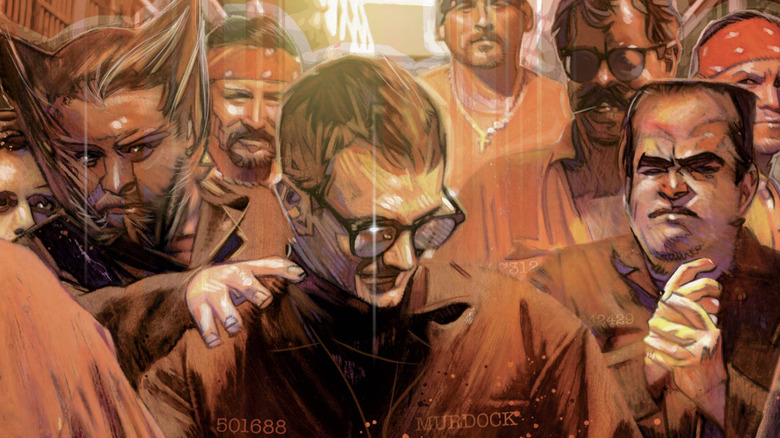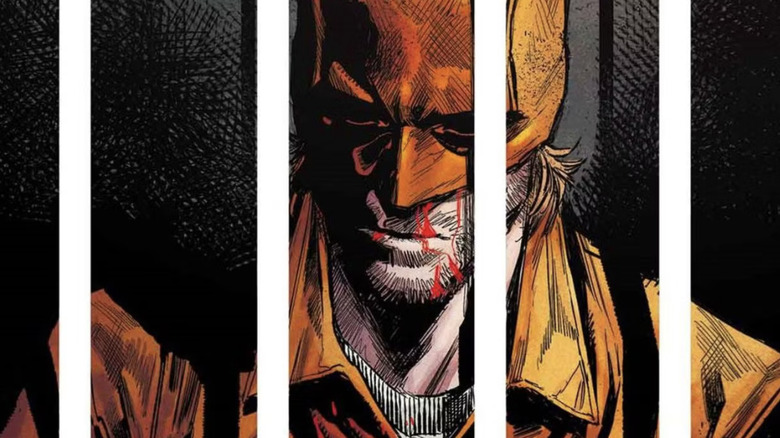This Marvel Superhero Has Been Sent To Prison...Twice
We may receive a commission on purchases made from links.
Marvel's Daredevil will soon be "Born Again" when the Disney+ series, reuniting the cast of the Netflix "Daredevil" series, finally premieres. Judging by the "Born Again" trailer, one of the new characters is feline-themed vigilante Hector Ayala/White Tiger (played by Kamar de los Reyes).
Daredevil fans might recognize that name, because in Brian Michael Bendis and Manuel Gutierrez's comic storyline "Trial of the Century," Matt Murdock defends White Tiger in court. Hector, falsely accused of murder while wearing his costume, faces a prosecutor eager to bring superheroes down a peg — but don't worry, he never sees the inside of a prison cell.
It remains to be seen how closely White Tiger's onscreen arc will mirror the comic version. Season 2 of the original "Daredevil" included a stretch set in Ryker's Island (the Marvel counterpart to the real NYC prison, Riker's Island). After a failed defense from Nelson & Murdock, Frank Castle/The Punisher (Jon Bernthal, who's also back in "Born Again") was convicted of vigilantism and spent a few episodes inside, a pawn of the Kingpin's (Vincent D'Onofrio) plan to eliminate his rivals.
Matt himself then paid the imprisoned Fisk a visit in the episode "The Man in the Box," leading to an explosive confrontation where Fisk finally realizes two of his enemies are the same man. The third, final, and best season of the original "Daredevil" featured in its fourth episode, "Blindsided," a 10-minute one-take of Matt caught in a prison riot at Ryker's, barely making it out.
Since Matt Murdock is a lawyer, it makes sense that his stories would explore the criminal justice system. But it's not always his friends, or anti-hero allies, who end up behind bars. In the pages of Marvel Comics, our hero has been incarcerated twice himself — once as Matt Murdock, and once as Daredevil.
How Matt Murdock became The Devil in Cell Block D
The most pivotal storyline from Bendis' run on "Daredevil" is "Out" (published in "Daredevil" issue #32-40, drawn by Alex Maleev). Minor criminal Sammy Silke (a friend of the Kingpin's son, Richard Fisk) trades Daredevil's secret identity to the FBI in a plea deal. The secret is then leaked to newspaper the Daily Globe, and thus all of New York.
For the rest of Bendis' run, Daredevil's true identity is an open secret. Matt continues to deny he is Daredevil for legal and safety reasons, but most everyone is just humoring him. Bendis and Maleev's last arc, "The Murdock Papers," ends with Kingpin offering the FBI concrete proof that Matt is Daredevil in exchange for parole. The proof doesn't and never existed, but Daredevil is still arrested. This works out even better for the FBI, because now Matt Murdock is locked up with Daredevil's greatest enemy.
Bendis spoke to CBR in 2006 at the end of his "Daredevil" run, delving into why he told his story the way he did. For one thing, he felt that "out of all the Marvel heroes, Matt Murdock has been the most careless with his secret identity," so the secret getting out would make sense and could act as a commentary on celebrity/paparazzi culture.
Bendis had wanted to end his run with Matt going to prison, but he only pulled the trigger because the book's next writer, Ed Brubaker, was willing to start his "Daredevil" run there. "This is the ending that I had originally hoped to do, but I realized it was the most obnoxious thing you could do to the new writer and I wasn't sure who the new writer would be when we announced we were wrapping it up," recalled Bendis.
Speaking to Daredevil fansite ManWithoutFear.com, Brubaker said he had also come up with the idea of Matt going to prison. Brubaker, who didn't want to put Matt's secret identity back in its genie bottle, thought an imprisoned Daredevil would build on Bendis' run while also doing something new. "Really, the only thing that changed for me was how quickly [Matt] got to prison. He was going to be put there at the end of my first arc, initially, but this was even better. I got to jump right into the deep end, and I loved that we actually had a hand-off with a cliffhanger ending, in some ways," Brubaker recalled.
So, Brubaker's "Daredevil" run opened with six-part story "The Devil in Cell Block D" (drawn by Michael Lark). The story features Matt's loved ones trying to get him out of prison, and Iron Fist goes out crime-fighting in a Daredevil costume to give the hero an alibi. Meanwhile, Daredevil's enemies inside try to kill him with the FBI's tacit approval.
Matt is caught in a double-bind: His one remaining bit of plausible deniability is that (everyone assumes) there's no way a blind man could pull off the stunts Daredevil does. If Matt defends himself inside, though, everyone will conclude that he's just lying about being blind. His enhanced senses, too, make the loud noises and putrid smells of Ryker's intolerable.
Brubaker, a crime comic master, excels at taking the "Daredevil" baton from Bendis and writing a gritty prison-set drama without indulging in cliches. (In issue #85, when a prisoner tries to get profound and claim prison changes men, Matt quips: "Seems like prison mostly changes men into philosophers about what prison does to men.")
By continuing so directly from Bendis' "Daredevil," Brubaker's run stands in the shadow of its predecessor's legacy, but the quality control is seamless. Brubaker would ultimately end his time on Daredevil with another major cliffhanger — in "Daredevil" #500 (returning to the series' original numbering), Matt agrees to lead ninja cult the Hand — but that's a story for another time.
Chip Zdarsky sent Daredevil back to prison
Charles Soule's 2015-2018 run on "Daredevil" saw Matt regain his secret identity, with everyone across the world (except Foggy Nelson) forgetting that Matt is Daredevil. (This is later revealed to be the work of the Purple Man's children, who inherited their father's mind-control powers that he used on Jessica Jones.) With his identity restored, Matt testifies in court as Daredevil. This establishes a legal precedent, ratified by the Supreme Court, that superheroes can be considered a legally distinct identity from the person under their mask.
The next "Daredevil" writer, Chip Zdarsky, built on these two threads for his run. Zdarsky's "Daredevil" (drawn primarily by Marco Checchetto) opens with Matt accidentally killing petty criminal Leo Cararo while stopping a robbery. Eventually, Matt decides he needs to do the time to make up for his sin, and is sentenced for manslaughter. But because of legal precedent, Daredevil is the one sentenced; his prison uniform even includes an orange mask so he can cover his face.
Zdarsky's run is structured like a mixtape album, combing through previous "Daredevil" stories to find a new beat through the familiar. Daredevil assumes command of the Fist, a redux of "Shadow Land" where he led the Hand. Matt befriends and confides in a nun, seemingly like Mother Maggie from the comic "Born Again," but halfway through she's revealed to be a disguised Typhoid Mary, the villainess introduced during Ann Nocenti and John Romita Jr.'s "Daredevil." During the first section of the run, Matt (convinced the Daredevil identity is useless now that he's taken a life with it) goes back to his simple black costume popularized by the Netflix show. Putting Matt Murdock back in prison is Zdarsky's tribute to Brubaker's "Daredevil."
The story arc titles call out to Matt's predicament too; volume 6 of Zdarsky's "Daredevil" is "Doing Time." Volume 7 is "Lockdown," which refers to both Daredevil being imprisoned and Bullseye (who has gotten his hands on cloning tech) going on a sniper rampage through New York City, forcing everyone to stay inside. (It's the wildest COVID-19 allegory I've ever come across.) While Matt is locked up, Elektra steps up as a new Daredevil, out to prove to herself and Matt that she can be a hero worthy of him. However, this is only the midpoint of Zdarsky's "Daredevil" saga, which he collectively calls "To Heaven Through Hell."
After Daredevil is released from prison, the story goes into the "Devil's Reign" crossover event, when Mayor Wilson Fisk outlaws superheroes within NYC's borders, using drafted super-villains to enforce the ban. The premise evokes "Civil War," but is retailored to fit into contemporary concerns about police brutality and militarization.
Matt's time locked up changes him, too, making him reconsider the effectiveness of the justice system in which he's worked. After he and Elektra leave New York to lead the Fist, Matt attacks super-villain prison the Raft and offers the freed prisoners a place in his army, deciding he will rehabilitate and reforge them with new, heroic purpose.
As the ending of "Echo" teased last year, "Daredevil: Born Again" will feature Mayor Wilson Fisk. It remains to be seen how much of "Devil's Reign" will make it into the series, but again, since Daredevil is a lawyer, he's the Marvel character most suited to explore the very real (and very American) issues of mass incarceration. He is also a defense attorney, so of course he believes in the second chances our carceral system so rarely gives.
"Daredevil: Born Again" premieres on Disney+ on March 4, 2025.


